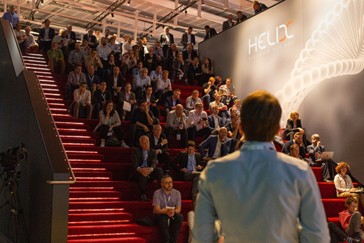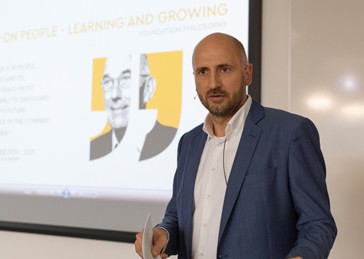- More than 120 attendees discussed fashion trends.
(Marchtrenk, Upper Austria, 17 October 2019) The increasingly difficult search for employees, higher service levels, unpredictable demand: These are the biggest drivers of automation projects in fashion logistics. As a result, apparel specialists will not be able to avoid investing in state of the art intralogistics solutions in the upcoming years. This was the bottom line of the first Fashion Expert Days hosted by intralogistics provider TGW Logistics Group.
More than 120 fashion experts, including representatives from GAP, Puma and Urban Outfitters, accepted the invitation to come to TGW headquarters in Marchtrenk (Upper Austria), where they discussed logistics trends and challenges in the fashion industry together with researchers, solution providers, and representatives of well-known fashion brands. Visitors from Europe, Asia, and North America also toured the interactive showroom Helix and TGW company headquarters.

Higher service levels as intralogistics drivers
Supply chain experts from Puma, GAP, and Urban Outfitters unanimously emphasized that the main drivers for a number of different automation projects in their companies are the lack of employees and higher service levels as a result of increased customer expectations. This was also confirmed by a quick participant survey via app: 100 percent of those surveyed expect service levels to go up so far in the next five years that same-day delivery or next-day delivery will become the industry standard. The majority of respondents are not going to rely on more employees or less warehouse automation to solve these challenges in their distribution centers, but they will instead rely on highly automated solutions.
Changing business models

Concerning the issue of unpredictable demand, Franziskos Kyriakopoulos, CEO of 7LYTIX, emphasized that big data analysis and predictive analytics are very effective for short-term forecasts. Medium-term or even long-term forecasts are inaccurate, however. Predictive analytics is a technology that learns from experience (data) to predict the future behaviour of individuals in order to drive better decisions. Because it’s based on the past, it can only be used for short term predictions. So, the question is how to deal with long term scenarios, where the balance between brick-and-mortar retail and e-com channels represents the biggest challenge.
Raffaele Destro, Industry Manager for Fashion at TGW, emphasized that it is crucial to have a high degree of flexibility within the supply chain in order to be able to deal with changes: “In intralogistics, companies must be prepared for quickly changing levels between distribution channels and business models. Therefore, businesses need to remain flexible and agile as far as intralogistics is concerned.”
To help companies become prepared for the future, TGW offers door-to-door intralogistics solutions where processes are optimized thanks to the use of automation. FlashPick® (based on one-to-one picking stations) or OmniPick (based on pocket sorting systems) are the two standardized split case order fulfilment systems at the core of any TGW Fashion solution and can be adapted to the needs of any apparel business. “Both TGW systems have been designed to be channel independent, which means they can process items in the same efficient way for any combination of retail, wholesale and e-com orders”, Destro explains.
Artificial intelligence
Maximilian Beinhofer, Head of Cognitive Systems Development at TGW, showed just how far OmniPick’s development has come. Aided by artificial intelligence, TGW has developed Rovolution, an intelligent robot, which picks goods from a container and automatically places them either into an order carton or tote (FlashPick®) or feeds an automated induction station for pockets (OmniPick). Combined with the automated unloading of the pockets, this results in a zero-touch system, which means that no employee has to intervene manually in the process.
Standardized modules, fast implementation

Anyone wishing to automate their systems has to be prepared to spend some money on that. This is just as true today as it was five years ago. According to TGW, however, the crucial difference is that TGW’s two new automation solutions, FlashPick® and OmniPick, consist of standardized, pre-manufactured modules that can quickly be adapted to different business models. “This does not eliminate the need to individually adapt a particular system for a customer, but it does make the process much faster,” said Christoph Wolkerstorfer, CSO at TGW Logistics Group. The advantages of this approach are: Proven optimized technology, fast installation of the system, faster commissioning, and easier scaling.
Because TGW does not offer all the technologies along the fashion supply chain itself, business partners also gave presentations at the event. Marco di Pietro, CEO of IdeaPura, from Switzerland, spoke about the advantages of RFID technology when it is used from manufacturing to the point of sale. Francesco Ponti, CEO at CMC Machinery, from Italy, presented information on the way fully automated packing machines work that create packages adapted to the product size. When integrated into FlashPick® and OmniPick, this technology allows for zero-touch Pick & Pack processes even for e-commerce orders.
Whether speaking about upgrading or new distribution centers: At Fashion Expert Days, major fashion brands representatives emphasized that their automation journey will continue on. According to Kevin Kuntz, Senior Vice President of Global Logistics Fulfillment at GAP, after having installed TGW One-Touch receiving systems (which are automated inbound and storage systems based on Miniload technology), his company is now planning on purchasing their ninth shuttle system for a distribution center in Columbus, Ohio. And the German sporting goods specialist, PUMA, is pushing ahead with the centralization of its European distribution network. Maximilian Molkenthin, Senior Head of Logistics, reported that the new Central European Warehouse in Geiselwind, Bavaria, is scheduled to start operations in spring of 2021. At the core of the system is TGW’s FlashPick® for automated single-item picking.

